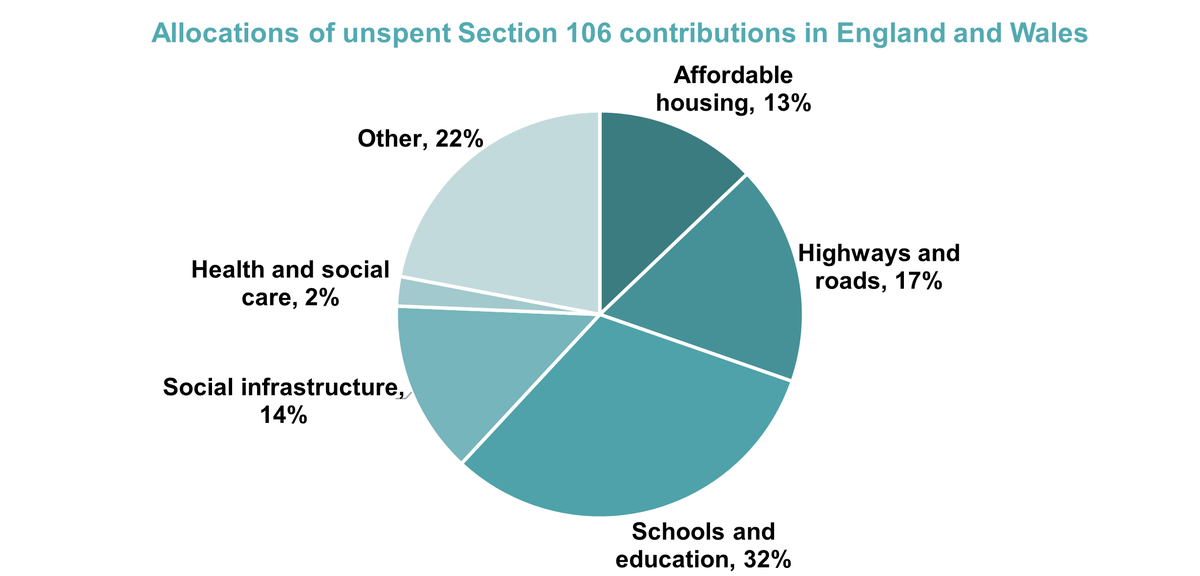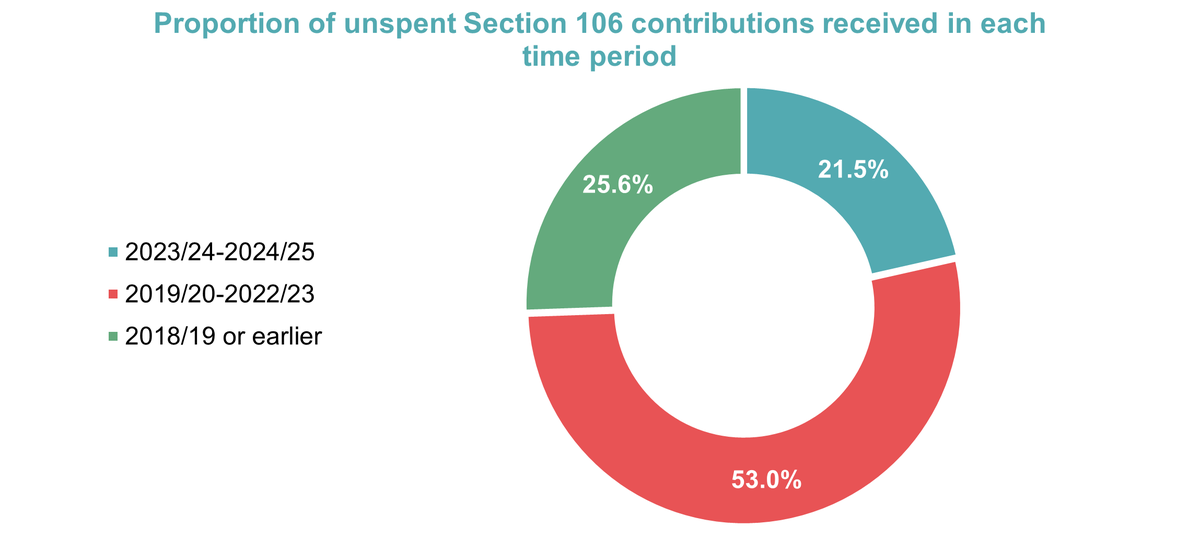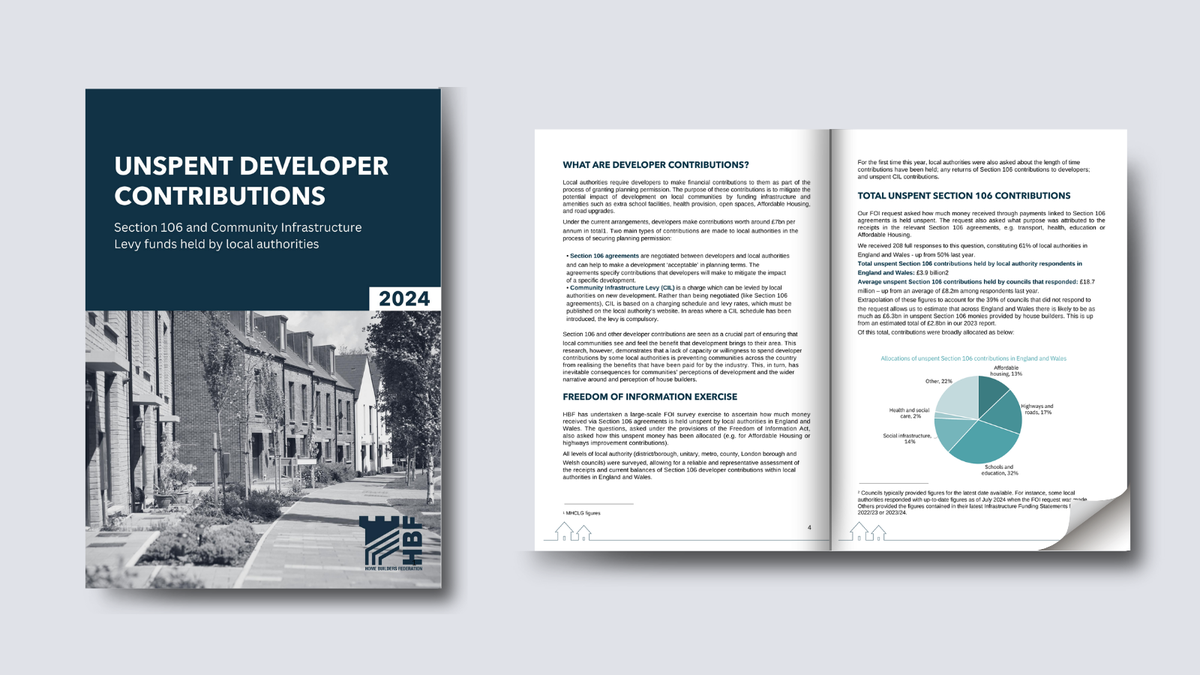Section 106 and Community Infrastructure Levy funds held by local authorities
Contents
Unspent funds held by local authorities
HBF member can view the full results from HBF's Freedom of Information exercise by creating or logging in to a HBF account.
View our searchable data table
Summary
New HBF research estimates that local authorities in England and Wales are sitting on over £8 billion of infrastructure payments by developers, including over £6bn from Section 106 agreements and almost £2bn raised through the Community Infrastructure Levy (CIL).
The research is based on a Freedom of Information (FOI) survey which received responses from 208 local authorities. The responses show that, on average, councils hold £19 million in unspent Section 106 contributions.
At a time when much of the existing school estate is unsafe and in disrepair, the results also suggest that £2bn of Section 106 contributions earmarked for new schools, enhancements and educational facilities is held unspent, including £143m held by Oxfordshire County Council.
A further £800m provided by developers for much-needed Affordable Housing is estimated to be sitting in local authority bank accounts. Local authorities in major cities with communities at the sharp end of the housing crisis hold the greatest sums of Section 106 monies allocated for Affordable Housing – with six of the top ten councils with the largest Affordable Housing sums unspent being in London.
HBF’s estimate of the total amount of unspent Section 106 contributions has more than doubled since last year, suggesting there is a growing backlog of infrastructure projects that local authorities have not yet delivered - and around a quarter of the unspent contributions have been held for more than five years. Indeed, some councils admit to holding on to funds for more than 20 years, completely severing the link between the payment of the contributions and the mitigation of a development’s impact.
What are developer contributions?
Local authorities require developers to make financial contributions to them as part of the process of granting planning permission. The purpose of these contributions is to mitigate the potential impact of development on local communities by funding infrastructure and amenities such as extra school facilities, health provision, open spaces, Affordable Housing, and road upgrades.
Under the current arrangements, developers make contributions worth around £7bn per annum in total (MHCLG). Two main types of contributions are made to local authorities in the process of securing planning permission:
- Section 106 agreements are negotiated between developers and local authorities and can help to make a development ‘acceptable’ in planning terms. The agreements specify contributions that developers will make to mitigate the impact of a specific development.
- Community Infrastructure Levy (CIL) is a charge which can be levied by local authorities on new development. Rather than being negotiated (like Section 106 agreements), CIL is based on a charging schedule and levy rates, which must be published on the local authority’s website. In areas where a CIL schedule has been introduced, the levy is compulsory.
Section 106 and other developer contributions are seen as a crucial part of ensuring that local communities see and feel the benefit that development brings to their area. This research, however, demonstrates that a lack of capacity or willingness to spend developer contributions by some local authorities is preventing communities across the country from realising the benefits that have been paid for by the industry. This, in turn, has inevitable consequences for communities’ perceptions of development and the wider narrative around and perception of house builders.
Freedom of Information exercise
HBF has undertaken a large-scale FOI survey exercise to ascertain how much money received via Section 106 agreements is held unspent by local authorities in England and Wales. The questions, asked under the provisions of the Freedom of Information Act, also asked how this unspent money has been allocated (e.g. for Affordable Housing or highways improvement contributions).
All levels of local authority (district/borough, unitary, metro, county, London borough and Welsh councils) were surveyed, allowing for a reliable and representative assessment of the receipts and current balances of Section 106 developer contributions within local authorities in England and Wales.
For the first time this year, local authorities were also asked about the length of time contributions have been held; any returns of Section 106 contributions to developers; and unspent CIL contributions.
Total unspent section 106 contributions
Our FOI request asked how much money received through payments linked to Section 106 agreements is held unspent. The request also asked what purpose was attributed to the receipts in the relevant Section 106 agreements, e.g. transport, health, education or Affordable Housing.
We received 208 full responses to this question, constituting 61% of local authorities in England and Wales - up from 50% last year.
Councils typically provided figures for the latest date available. For instance, some local authorities responded with up-to-date figures as of July 2024 when the FOI request was made. Others provided the figures contained in their latest Infrastructure Funding Statements for 2022/23 or 2023/24.
Total unspent Section 106 contributions held by local authority respondents in England and Wales: £3.9 billion
Average unspent Section 106 contributions held by councils that responded: £18.7 million – up from an average of £8.2m among respondents last year.
Extrapolation of these figures to account for the 39% of councils that did not respond to the request allows us to estimate that across England and Wales there is likely to be as much as £6.3bn in unspent Section 106 monies provided by house builders. This is up from an estimated total of £2.8bn in our 2023 report.
Of this total, contributions were broadly allocated as below:

Top 20 local authorities
Of the top 20, 11 are county councils, 5 London boroughs and 4 unitary councils.
The top 20 councils collectively hold around £2bn, with Oxfordshire County Council holding the largest amount of unspent Section 106 monies among respondents. Recent Committee notes published by Oxfordshire County Council highlight “an issue with the age profile of monies held…with some monies having being held for over 20 years without any movement other than accruing of interest”.
Affordable Housing
- Estimate of total held unspent in Affordable Housing contributions across England and Wales: £817.1 million
- Average amount of unspent Affordable Housing contributions held per council: £2.4 million
The 10 councils with the largest amount of unspent Affordable Housing contributions were:
Our research shows that local authorities in major cities with communities worst affected by the housing crisis are holding the greatest sums of monies that have been allocated for Affordable Housing. Six of the ten councils with the highest amounts of unspent Affordable Housing contributions are in London, where over 60,000 people are living in temporary accommodation (Trust for London), and Cardiff and Sheffield are also amongst the top ten.
In Wokingham, where the council is holding £41m paid for by developers to support the delivery of Affordable Housing in the borough, local house prices are more than 10 times local wage levels. Data released by Wokingham Borough Council showed that in 2022-23, the council spent £680,000 on emergency accommodation for homeless households and a further £200,000 on Temporary Accommodation (WhatDoTheyKnow).
£817 million in unspent Affordable Housing contributions could support the delivery of around 11,000 Affordable Homes (based on Affordable Homes Programme expenditure in Homes England’s Annual Report).

Highways and roads
- Estimate of total held unspent in highways and roads contributions across England and Wales: £1.1 billion
- Average amount of unspent highways and roads contributions held per council: £3.3 million

£1.1 billion could fund the repair of around 12.6 million potholes (Asphalt Industry Alliance).
This sum is also equivalent to the entire annual Department for Transport capital budget for maintaining the local road network (National Audit Office).
Hampshire County Council, which holds the largest amount of unspent developer contributions earmarked for highways and roads, is spending £111m of taxpayers’ money over two years on road surface improvements (Daily Echo).
Schools and education
- Estimate of total held unspent in schools and education contributions across England and Wales: £2 billion
- Average amount of unspent schools and education contributions held per council: £5.9 million
The £142m for schools and educational facilities held by Oxfordshire County Council is by far the largest of any respondent and constitutes around half of the Council’s total unspent contributions. These sums are held unspent even though the Council has itself admitted that in some parts of the county, such as Banbury and Bicester, “some schools were required to create "bulge" classes at short notice” and new schools are needed to meet extra demand generated by housing.
Furthermore, objections raised by local campaign groups and parish councils to new housing developments in Oxfordshire - such as the Hanwell Fields development near Banbury – have highlighted that local schools are oversubscribed or too far away.
£2 billion in unspent education contributions could support 126,000 new school places (National School Delivery Cost Benchmarking Report).
This sum is also equivalent to the entire annual Department for Education budget for school rebuilding, maintenance and repair (National Audit Office) - at a time when much of the school estate is unsafe and in need of urgent maintenance.

Social infrastructure
Social infrastructure includes recreation, open spaces and play areas.
- Estimate of total held unspent in social infrastructure contributions across England and Wales: £873.1 million
- Average amount of unspent social infrastructure contributions held per council: £2.6 million
£873 million in unspent social infrastructure contributions could fund around 1,000 sports halls and 4,700 community games areas (Sports England).

Healthcare and other contributions
It is estimated that an additional £148.7m is held unspent across the country for health and social care services, an average of £439,000 per council. Milton Keynes City Council holds the most in unspent health and social care contributions (£7.5m).
Furthermore, an additional £1.4bn is estimated to be either unallocated or allocated to infrastructure that doesn’t fall into any of the above categories.
Length of time contributions held unspent
This year, our FOI also asked councils how long they have held unspent monies for. 112 councils provided a full response to this question (33% of all councils).
The responses show that:
- Just 21% of the total Section 106 contributions held unspent have been received within the past year.
- 26% of unspent Section 106 contributions have been held for longer than five years.
- This would suggest that around £1.6bn of vital funds for Affordable Housing and other infrastructure has been sitting in council bank accounts for more than half a decade. Some councils, such as Oxfordshire County Council, are reported to have held funds for more than two decades.

Returns to developers
If developer contributions are held for too long, some Section 106 agreements stipulate that they can be returned to the payee as projects are deemed unlikely to be delivered. This means that communities do not receive all the benefits of development that local authorities have committed to.
Our FOI request shows that 80 local authorities – around a third of all those who responded to this question – have returned Section 106 money to developers in the past five years, with a total of £20.6m being returned in total. Among respondents, Essex County Council has returned the most to developers in the past five years (£5.4m).
House builders very rarely track what happens to their Section 106 payments and few seek reimbursement if it is found to have gone unspent. The home building industry would always prefer that money provided for a specific purpose is spent accordingly and within good time as this ultimately benefits the residents in the new communities built by the developer.
Unspent Community Infrastructure Levy
The final question our FOI request asked was: ‘How much money received via Community Infrastructure Levy (CIL) payments is currently held, unspent, by the local planning authority?’
There were 97 full responses to this question, constituting 60% of all councils estimated to have a CIL as of 2022 (Planning).
The responses show:
- An average of £11.4m of CIL contributions is held per council.
- Extrapolating this out to all councils which have a CIL, there is an estimated £1.8bn of CIL held unspent in total across England and Wales – raising the total combined estimate of unspent developer contributions to over £8bn.
- The London Borough of Brent holds the most in unspent CIL contributions (£167.6m).
Strategic infrastructure provided by CIL tends to be more expensive than amenities funded by Section 106, and so it can take longer for local authorities to acquire sufficient money for these projects. However, it is still important to highlight the significant sums of CIL contributions that have not yet been spent but will deliver benefits for communities across the country in the years ahead.
Wales
16 Welsh local authorities responded to the FOI request, out of a total of 22 (73% response rate). This is up from 14 councils last year.
The responses from Welsh councils show:
- An average of £5.8m of Section 106 contributions is held unspent per council - up from an average of £5.1m last year.
- If extrapolating out to all Welsh councils, around £128m is likely to be held unspent in total across Wales - up from £112m last year.
- Cardiff Council holds the most in unspent contributions in Wales, holding £33.4m, including £10m for Affordable Housing and £8.2m for highways and roads.
Conclusions
Developer contributions can build vital support for new developments among local communities by funding new infrastructure and Affordable Housing. It is worrying, therefore, that payments made to councils to provide services and infrastructure are not always feeding through to new provision for the enjoyment and utility of new and existing communities. In turn, this lack of delivery by some councils leaves residents unsure of the benefits that development has brought to their area.
Therefore, while it must be acknowledged that developer contributions cannot be spent immediately, it is important to highlight the existence of a significant pipeline of billions of pounds of funding provided by developers for new roads, schools and open spaces that has not yet been spent. These large unspent sums are often underappreciated in debates about the impact of new development.
With regards to Affordable Housing, the delivery of Affordable Housing in England has been increasingly reliant on Section 106 contributions from developers as funding for Government grants has reduced. For instance, over the twenty years from 2000 to 2023, the proportion of Affordable Homes delivered through Section 106 agreements in England rose from 4% to just under 50% (MHCLG). Given the increasing reliance on Section 106 funds for Affordable Housing provision, it is especially worrying that these contributions are not being spent on vital new housing provision in a timely manner, with around £800m estimated to be unspent.
Recommendations
This research shows that much of the Section 106 contributions made by developers are being held unspent by local authorities. House builders are not advocating refunds of Section 106 payments. However, the industry is concerned that inaction by some councils and a lack of local authority capacity, along with fiery rhetoric about development and developers from some politicians and campaign groups, is contributing to negative perceptions of house building across the country.
There are a number of reasons why sums might be held unspent by local authorities for extended periods of time, including insufficient staff and resources in local authority planning departments; councils waiting for sufficient funds to be accrued to deliver projects; and a lack of transparency and effective auditing and monitoring of funds by councils. For example, it has been reported that West Northamptonshire Council “doesn’t have an overall picture of financial contributions through the community infrastructure levy (CIL) and S106” due to council reorganisation.
HBF’s proposals to mitigate the issue of unspent developer contributions include:
- Infrastructure Funding Statements (IFS) should outline the reasons why developer contributions have not yet been spent and how long money has been held for. All councils should also provide a publicly available database of their developer contribution funds, as some already do, to increase transparency and ensure effective monitoring and auditing.
- Information on unspent S106 and CIL payments, and the length of time monies have been held, should be taken into account when council objections to new planning applications cite concerns over infrastructure pressures.
- Central Government should consider legislative options or stronger guidance to require developers' contributions to be spent by local authorities according to their negotiated purpose and within their agreed time limit.
- Further thought needs to be given as to how local authority planning departments can be placed on a sustainable financial footing. This will help to ensure there are sufficient staff and resources for the monitoring, allocating and overseeing of Section 106 spending.
- A badging scheme, similar to blue plaques, could be introduced to ensure that new infrastructure and facilities funded by developer contributions are easily identifiable to the public.
Ultimately, we hope that more transparency about how developer contributions are monitored and handled by local authorities will increase public understanding of such provision, speed up delivery of infrastructure projects, and create a more informed, sensible debate about housing supply.
